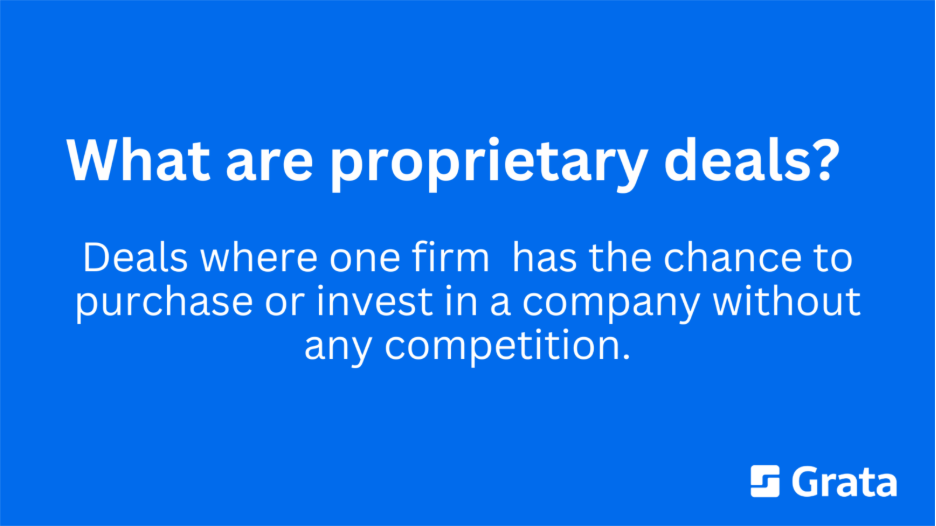Mergers and acquisitions continue to play a huge role in our economy. The timely injection of capital or strategic restructuring can help firms remain competitive in their market and outlast competitors.
In 2024, the global M&A industry saw nearly 40,000 deals worth a combined $3.4T, according to Morrison Foerster.
While many deals are traditionally sourced through intermediaries and advisors, proprietary deals present a unique opportunity to firms across the globe.
Proprietary deals do require more legwork up front — but they also allow you to find opportunities with lesser-known companies, conduct one-on-one negotiations with the seller, and speed up the process of information gathering.
In other words, your company is in the driver's seat to exponentially increase M&A deal flow.
What Is Proprietary M&A Deal Flow?
To explain proprietary M&A deal flow, we must start with what proprietary deals are: deals where one firm — hopefully yours — has the chance to purchase or invest in a company without any competition.

Most often, this happens when there is a pre-existing relationship between a firm and a company, or when the match between the two is very clear.
In addition, it’s more likely that a proprietary deal will happen when the target company is not actively looking for deals and therefore is not publicly looking for investors. It probably doesn’t even share financial data online.
Now, proprietary M&A deal flow is the steady stream of such exclusive investment opportunities that a particular firm has access to. This usually comes due to its strong relationships with companies, intermediaries, service providers, and industry experts.
Essentially, it’s the pipeline of unique investment opportunities that are not available to the wider market, making it a highly valuable resource for private equity firms and all kinds of dealmakers alike.
The advantages of proprietary M&A deal flow include the ability to invest in high-quality assets before other market participants. This means you’re able to negotiate better deal terms and maintain a competitive edge in your market.
Moreover, proprietary M&A deal flow is critical to a successful deal sourcing strategy, as firms with strong proprietary M&A deal flow are often seen as more attractive partners to potential acquisitions and can therefore attract more deals.
To maintain and improve their proprietary M&A deal flow, firms must invest heavily in relationship-building with potential clients, industry experts, and other intermediaries. The adoption of deal sourcing software platforms is also increasing as a key method of obtaining better information on targets, which can save valuable time and resources.
The Benefits Of Proprietary M&A Deal Flow
The benefits of a proprietary M&A deal flow include a lack of competition in the deal, resulting in a better price for the company being acquired.
Moreover, since these deals happen privately, firms can negotiate and close the deal much faster than in traditional auction formats.
The other main benefit of proprietary M&A deal flow is that firms can gain a deeper understanding of the target company, leading to better strategic decisions and potentially higher returns on investment.
This happens because of the more intimate relationship required to make a proprietary deal - plus, since the deal negotiations are exclusive, there is much more opportunity to learn more about the business.
Overall, a proprietary M&A deal flow can provide significant advantages for firms looking to invest in private companies. The question is: how can you increase proprietary M&A deal flow?
How M&A Deal Flow Differs from Deal Sourcing
M&A deal flow strategies and general deal sourcing strategies have some similarities, but some key differences set them apart. Both types of deal sourcing strategies seek potential investment, acquisition, or partnership opportunities, but M&A deal flow differs slightly.
Deal sourcing refers to the proactive business development process of searching for targets, and, once vetted, engaging them in early discussions.
M&A deal flow is a blanket term that describes all of the ways firms generate deals. This can include proprietary deal sourcing as well as inbound deals from bankers or other service providers or M&A auctions. Achieving strong M&A deal flow means investing in multiple strategies that diversify risk and an overreliance on any one area.
How To Increase M&A Deal Flow
At a high level, dealmakers can keep their pipeline flowing smoothly by tapping into their personal networks, building relationships with bankers, and leveraging private market data platforms.
.png)
Here are several other methods dealmakers can use to increase their M&A deal flow:
1. Set up a website
Any modern company that wants to increase M&A deal flow needs a high-quality website so potential prospects can research you and your company. List your mission, team bios, portfolio (or prior transactions if you don't have a portfolio yet), contact information, and relevant social media handles.
Even if your team is small and agile, you can easily set up a website without learning to code through platforms like Squarespace and Wix. These platforms are also automatically mobile-friendly, so people can check out your company on the go.
2. Use LinkedIn
A 2024 study conducted by Omnicore Agency found that 4 out of 5 people on LinkedIn use the platform to drive business decisions, and 89% of B2B marketers use LinkedIn for lead generation, according to Wpromote.
Having a digital presence on LinkedIn signals to prospects that your company is established and legitimate, and ultimately increases your M&A deal flow. It also helps give them an idea of how you work and play with others. Publishing thought pieces on LinkedIn, commenting on posts from people in your industry, and engaging with others is a great way to boost your presence and show you're trustworthy.
3. Pin down a company data source
According to a 2020 study conducted by Accenture, 80% of executives agree that M&A activities require third-party providers for new technology adoption.
Googling only goes so far when you're looking to build out an M&A deal flow. Look into databases or company search engines to keep track of which sources provide the most lucrative and effective leads for you. It may also be worth tracking how much time it takes for you to find those leads, since some methods are way more time-consuming than others.
4. Get a data source for contact information
Keeping track of all your prospective deals can quickly get messy. Contact databases don't always have what investors need to know about companies, which is why it's helpful to build out your own. Using LinkedIn browser plug-ins is one way to get started and ensure that M&A deal flow is growing.
5. Get a CRM system
CRM, or customer relationship management, makes it easier for you to manage interactions with prospective customers. This will keep you from repeating the same interactions or losing vital information. They also help you collect data on which type of prospects are the best to close, and finally have a positive impact on M&A deal flow.
Some of the most popular options include:
- Salesforce – The industry standard for most modern companies
- DealCloud – A deal sourcing and fund management platform for capital markets
- Affinity – Another popular option for people who work in venture capital, private equity, and investment banking
- HubSpot – A multi-use tool that is well known among marketers
6. Use an outbound sales automation platform
Automating outbound sales messages spares you a good amount of manual labor, and then allows you to focus on tailored discussions once a prospect responds. It's important to develop a strong messaging cadence that hits on your company's most valuable points, and delivers emails spaced out over time so you don't overwhelm prospects.
Some of the most popular outbound platforms that can help you increase your M&A deal flow are:
- Outreach – Offers sales sequences, multichannel communication, and personalization at scale
- SalesLoft – Helps B2B sellers integrate with top CRMs, including features of cadence, automation, and analytics
- Reply – Automates email search, LinkedIn outreach, personal emails, and calls
- ActiveCampaign – Email marketing and automation tools for e-commerce, digital businesses, and B2B companies
- HubSpot – As mentioned above, this tool has a sales automation platform automatically built in
7. Hire interns for help
Building a pipeline of M&A deal flows is important work, but also very time-consuming if you're not using a specialized search engine or tech stack. College students and other recent graduates are a great option if you need to focus your energy on higher-level work. Just make sure to avoid free internships to keep your employment practices above board.
8. Get involved in the community
Similar to joining trade organizations, making yourself an active presence in the community is one of the best ways to establish your company and boost your M&A deal flow. Attend events, post thoughtful answers on forums, and slowly build up your reputation as a respectable leader who is here to help.
Common Deal Flow Bottlenecks
Due Diligence Delays
Conducting thorough due diligence is a crucial part of the dealmaking process, but an inefficient diligence phase can be a dealbreaker.
Extensive delays in the diligence process can eat away at the trust between the buyer and the seller. Additionally, the longer the due diligence process goes on, the more vulnerable the deal becomes to external factors like market fluctuations or the buyer finding another target.
Common reasons for delays in the diligence process include:
- The scope of the buyer’s documentation requests is excessive
- The seller is slow to respond to inquiries or provides incomplete information
- Multi-entity ownership or unclear asset structures lead to time-consuming complexities
To keep your deal flow moving smoothly, it’s important to communicate clearly and efficiently during the due diligence phase.
Misaligned Valuation
Sometimes, buyers and sellers are misaligned on pricing due to using different valuation methods, attempting to quantify intangible assets (e.g., brand name, intellectual property), overly optimistic projections, or competitive bidding.
If the buyer and the seller’s pricing expectations are mismatched, they could be in for a long, drawn-out period of negotiation. Ultimately, that can slow the whole process down and threaten the deal.
Dealmakers can use Grata’s Deals page to see the most accurate comps for their target companies. With the multiples summary bar, they can benchmark their deal quickly and easily to keep the process on track.
Buyer Financing Challenges
Another common deal flow bottleneck is challenges with financing. An enthusiastic buyer could sign a Letter of Intent (LOI) and then run into trouble securing the funds due to:
- Unfavorable lending conditions
- A lackluster credit profile or lack of collateral
- Unrealistic payment terms set up during early negotiations
Buyers should do as much financial prep work as possible to avoid delays and keep their deal flow running smoothly.
Regulatory Hurdles
All M&A transactions must comply with various antitrust laws, labor laws, and industry-specific regulations.
Larger deals tend to be more heavily subjected to regulatory scrutiny, but middle-market transactions are not immune from regulatory reviews from authorities such as the FTC. Prolonged investigations can delay the dealmaking process, and antitrust concerns can even lead to deal termination.
Staying up to date on industry regulations is crucial for dealmakers to keep their pipeline flowing.
Increase Deal Flow with Grata
Grata has the coverage, data depth, and comprehensive workflows that private market dealmakers need — all in one sleek, user-friendly platform. Learn about how we’re changing the game for dealmakers around the world here.
Ready to optimize your deal flow? Schedule a demo to get started.












